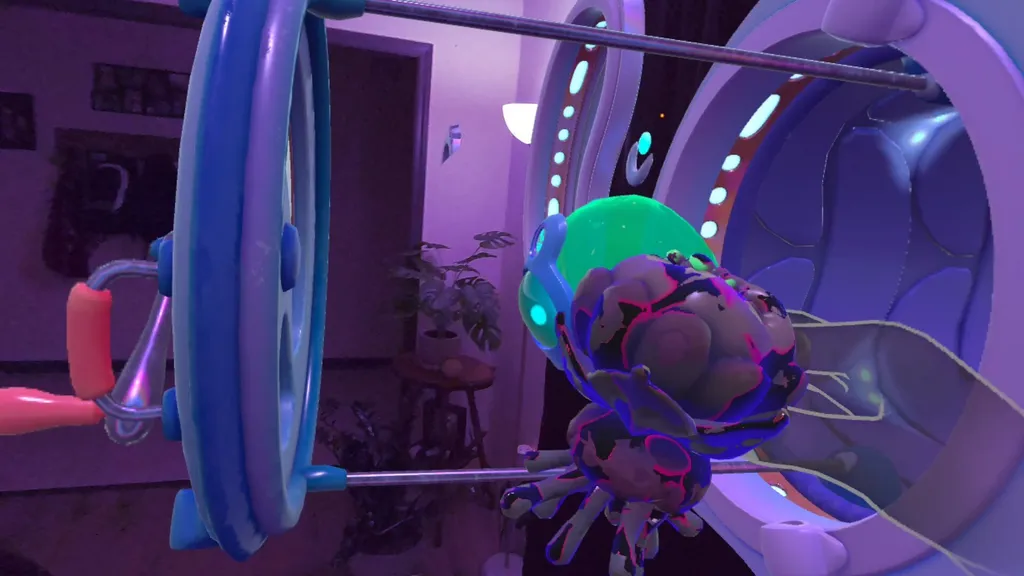Starship Home from Creature promises an adventure to the stars from your living room.
Does it deliver on its goal of transforming our homes into starships that will take us on an adventure to save the galaxy or does it burn up on entry? Read on for our full review.
What is it? A narrative-driven mixed reality adventure game where you rescue different plant species across the galaxy.
Platforms: Quest 3 and Quest 3S
Release Date: Out Now
Developer: Creature
Price: $19.99
Gameplay: Mixed Reality Immersion Meets Repetition
In Starship Home, you receive a misdelivered package with a kit that transforms your living space into a starship. The game's eight missions weave together the story of an interstellar blight affecting plant life across the galaxy. Your task is to embark on an adventure spanning the eight planets that have been affected in search of various plant species to rescue. Once you save a plant, you enter its dreams, filled mostly with psychedelic and whimsical mini-games.
Completing dream tasks lets you heal the plant, revealing the next leg of your journey. The plant dream mini games are a highlight of this experience, especially if you're like me and love the trippy weird side of immersive gaming. All of this comes together to provide an experience that is both fun and frustrating.
While the initial missions are captivating, repetition soon sets in. By about the third planet, it becomes clear that I'm doing the exact same tasks in the exact same order. Sadly, this pattern of rinse and repeat continued until the endgame. Each level essentially revolves around the same set of activities but with a different planetary backdrop. This makes playing Starship Home feel more like experiencing a highly polished tech demo on replay, versus the fully realized mixed reality adventure that Creature teased in the months leading up to the game’s launch.
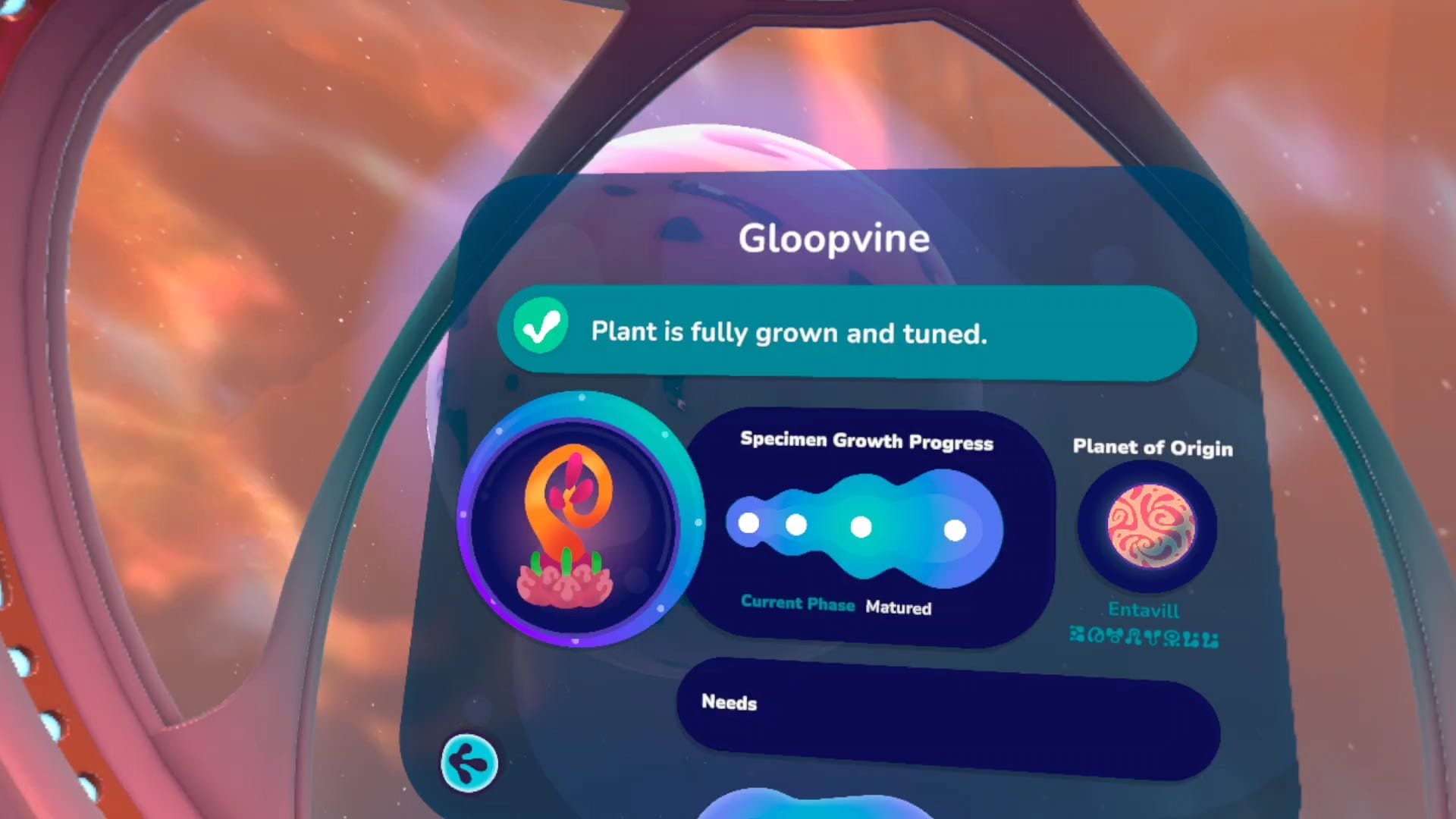
Another standout feature in Starship Home was the game's ability to utilize my entire play space to its full potential while leaving the Quest 3's boundaries turned off. Being unleashed like this creates a more dynamic and believable environment. One where physical movement within the space becomes part of the gameplay. Walking and interacting with virtual elements in a play space that fills my entire living and dining room helps create a deeply immersive experience.
Narrative and Audience: A Family-Friendly Voyage
The storytelling and dialogue in Starship Home seem to cater predominantly to a younger audience. The game's character interactions and overall tone resemble something you might expect to find in a show on Nickelodeon. This family-friendly approach makes it suitable for all audiences, but may leave mature players yearning for a more sophisticated narrative with a sidekick character that doesn't sound like a cross between Bart Simpson and Jeff Spicoli. On one hand, it makes the game accessible and understandable; on the other, it may frustrate adults looking for more nuanced and complex storytelling.
The simplistic dialogue and character development are clearly designed to engage a younger audience, which can be a double-edged sword. An eco-aware narrative serves an almost educational purpose, encouraging players to really think about our current environmental issues right here on planet Earth. In essence, the game feels more like Star Trek: Prodigy than Star Trek: Voyager, and may not meet the expectations of more seasoned sci-fi fans who were hoping for a deeper narrative experience.
Graphics and Passthrough: Purple Haze All In My Scene?
Starship Home looks good overall with its cartoonish art style, but there's problems with its visual execution. It suffers from some noticeable antialiasing issues, with rough edges that shimmer from across the room, detracting from the polished look of the assets seen in the game’s trailer. Visual anomalies like this are more apparent on augmented objects when seen against the color passthrough of the Quest 3. These graphical shortcomings can be a noticeable distraction at times, making objects within the game's mixed reality space appear less refined.
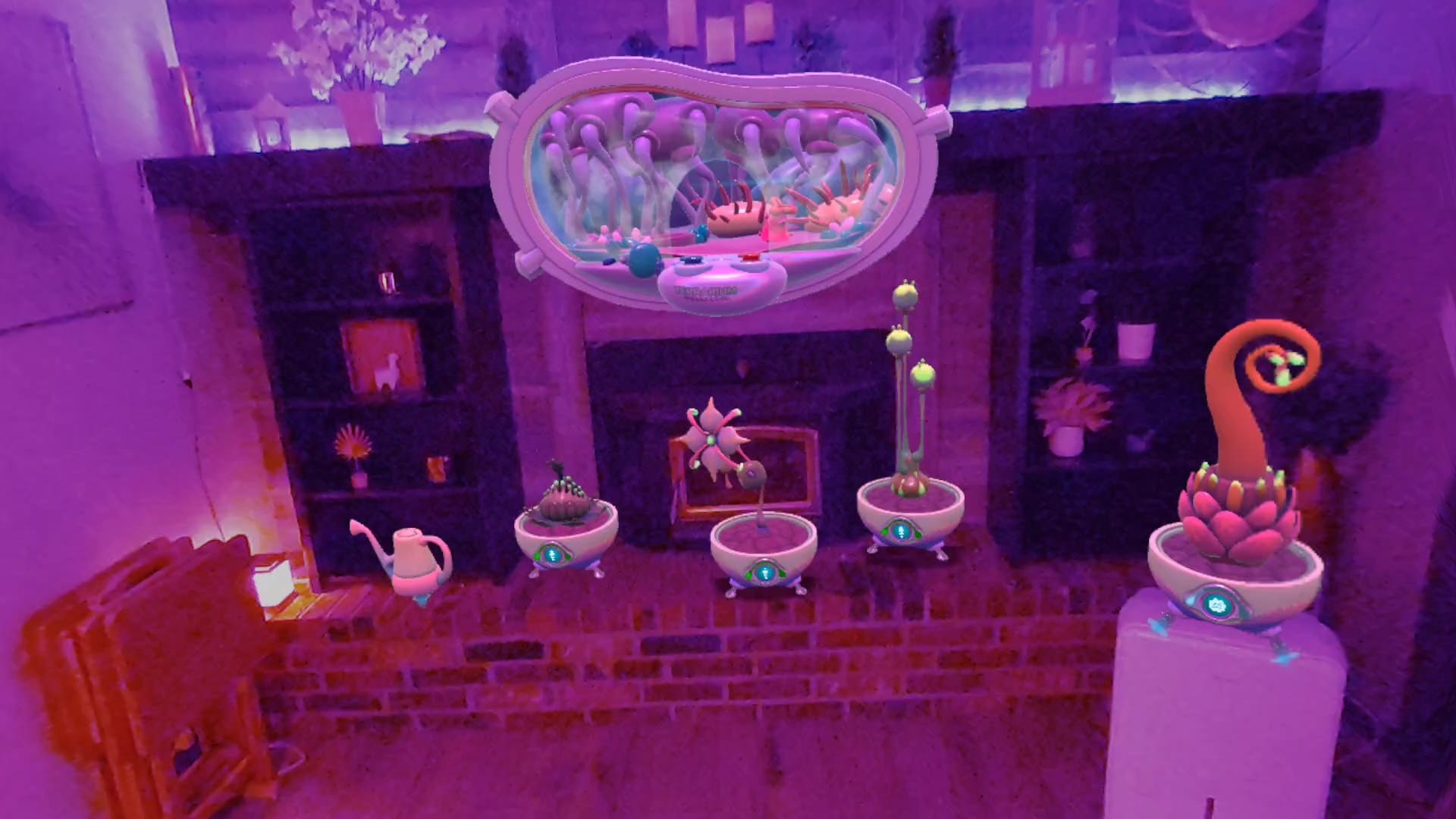
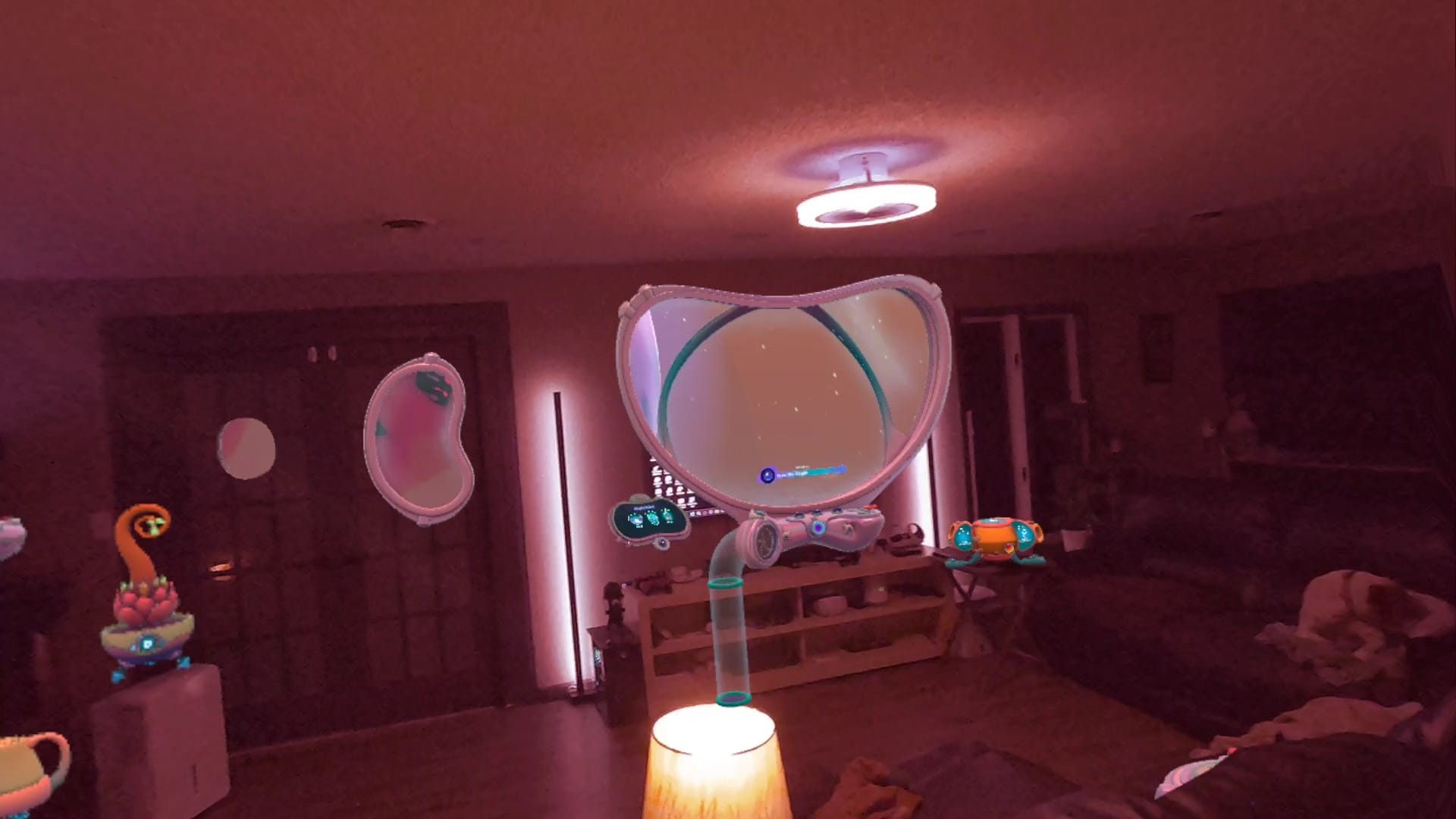
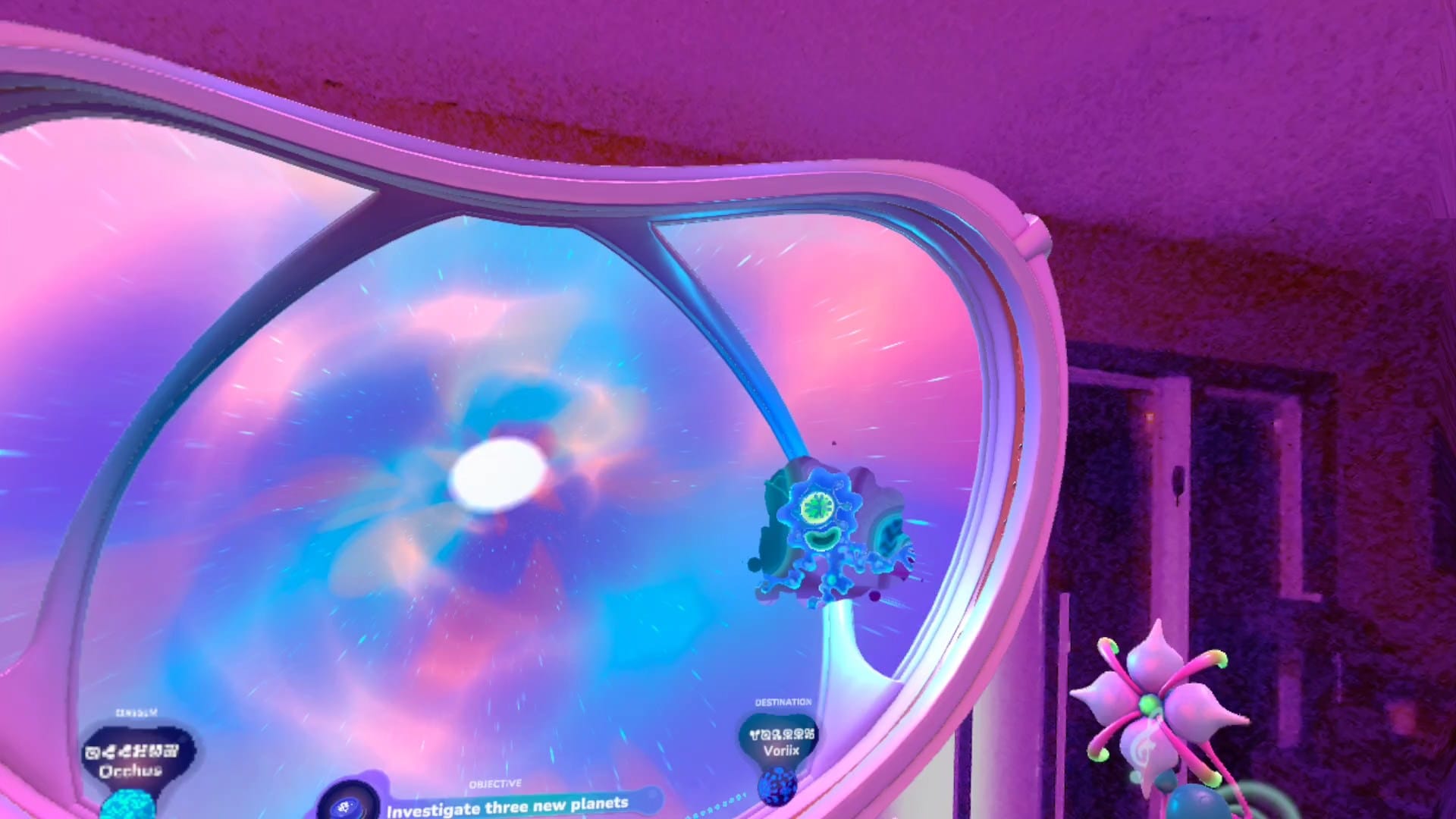

Using a colored mesh placed over most of the scenes further complicates things. Although this seems to be intended to enhance thematic elements found at each stop on the adventure, it severely impacts the clarity of the Quest 3's passthrough camera, highlighting its inherent graininess and distorting the real-world view even further. The altered and grainy passthrough image degrades the experience's visual integrity, seemingly creating a less cohesive fusion of the two realities being presented.
Controls and Tracking: Floating Hands in Shifting Rooms
Creature offers the flexibility of both hand tracking or traditional controllers. However, hand tracking is currently flawed due to the inconsistency in hand interactions. Attempting to grab or manipulate objects often results in missed touches, where your hand passes through items or fails to register the interaction entirely. This problem is even more frustrating during tasks, such as pulling weeds or opening the airlock door. On a few occasions, the grab mechanic would fail completely and just rip the virtual object I was interacting with right off the wall, causing me to have to stop and replace things often. This completely breaks any immersion I'm feeling at the time.
One particularly jarring bug with hand tracking involves a model that remains floating in space as you move about the room. This ghostly hand imprint sticks around long after you’ve left an area, further breaking immersion and causing some frustration as you constantly have to wave your hand in front of the tracking cameras just to get it to snap back.
Comfort
Since Starship Home is a mixed reality game, the usual comfort settings seen in VR games doesn't apply. All of your time is spent viewing passthrough images of your environment that are recreated by the Quest 3 at a much lower resolution than directly viewing the world and without the depth cues inherent to natural sight. Locomotion is natural since you just walk around the room, so there should be no worries of motion sickness for most players.
It's a pervasive glitch that happens often enough to be more than a minor annoyance, causing me to abandon playing the game with hand tracking and revert to the more traditional controller method, which works completely fine and as expected.
Another significant issue I frequently encountered during my playthrough was the failure of virtual objects to remain anchored. At times, items like tools and plants that were set close to the room’s scanned walls would seem to shift out of reach or disappear from the play area entirely. This required frequent in-game resets and even re-doing my room scan a few times, disrupting gameplay and pulling me out of the experience. These technical glitches highlight the gap between the game’s lofty goals and its current state, emphasizing the need for tighter spatial fidelity in mixed reality.
Starship Home Review - Final Verdict
Despite its numerous technical issues, I've enjoyed the adventure Starship Home provided. Creature's creative uses of mixed reality and narrative are passable and show a glimpse of what a fully realized MR title can achieve. However, persistent glitches and repetition make it a somewhat frustrating experience.
With more refinement and polish, Starship Home can potentially be one of the top mixed reality experiences out there. Playing it made me yearn for a deeper, more mature space adventure. If you want something less cartoonish, ASTRA offers a shorter but similar narrative-driven mixed reality experience with more realistic visuals. Overall, Starship Home is a good start and with some technical improvements, it could truly reach the stars.

UploadVR uses a 5-Star rating system for our game reviews – you can read a breakdown of each star rating in our review guidelines.

